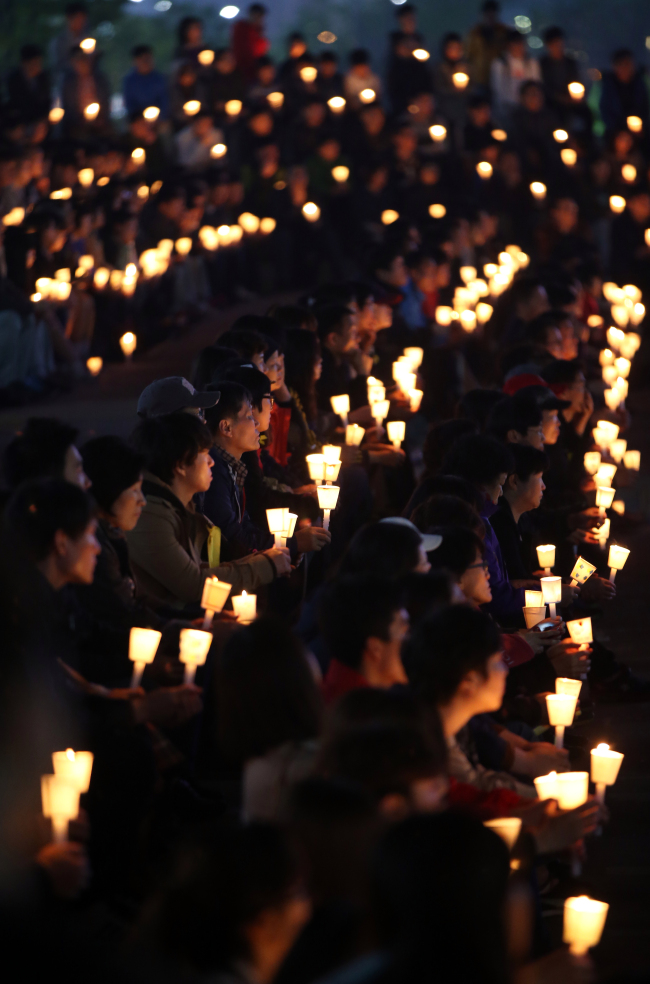ANSAN, Gyeonggi Province ― Tears, sighs and quiet loomed over the city of Ansan after last week’s Sewol tragedy left more than 300 passengers dead or missing ― most of them second-year students from Ansan’s Danwon High School.
Mourners in black laid white chrysanthemums at the altar set up inside the Ansan Olympic Memorial Museum, where photographs of the deceased students and teachers surrounded by flowers are placed. Several visitors sobbed as they read the numerous Post-it notes that covered the walls, wishing for the safe return of those still missing.
Outside, some of the mourners, tears streaming down their faces, were being comforted by volunteers inside tents set up by relief groups. More than 55,000 had paid their last respects at the Ansan Olympic Memorial Museum as of Friday afternoon.
“Just … come back,” wrote one visitor on a note.
“I’ve lived here for 35 years, and I’ve never seen the town this dark,” said Lee Hyoun-woo, a local historian working at the Ansan Cultural Center.
Residents voluntarily suspended all events that would evoke the slightest feelings of joy or laughter.
“To give you an idea, the adults taking the accordion, guitar and folk song classes at the (Ansan) cultural center have either canceled their lessons altogether or postponed them indefinitely,” Lee said.
Scheduled festivals in the city are also being dropped. The fifth annual Ansan Valley Rock Festival was canceled while Buddhists canceled ceremonies celebrating Buddha’s birthday on May 6.
Businesses, both large and small, reported a drop in sales.
“Last Friday, the streets were very quiet. I’d say maybe 70 percent of my hotteok went unsold,” said a woman surnamed Kim, who sells syrup-filled pancakes at a streetside stall in front of Jungang in downtown Ansan.
“The city is really quiet,” said Kim Yong-wha, an Ansan resident of 20 years and a salesman at the downtown Kia Motors dealership. “I’d say we’ve lost maybe 20 to 30 percent of our customers (since the accident).”
The town with a population of 762,000 has lost 248 students, either dead or missing, in the Sewol ferry disaster, according to the Gyeonggi Provincial Office of Education.
Many on the street seemed to have connections to the accident.
“I don’t know anyone personally who’s been affected by the accident, but I think three of my friends’ friends had lost a son or a daughter in the disaster,” said Kim.
Sun Jae-cheon, an employee working at the local Samsung Electronics retail shop, said, “A friend working across town had a younger brother who died.”
“We had about five or six students from Danwon who were killed,” said Ka Min-seok, an assistant manager at the admissions office of the Korea Hotel & Tourism Technical College, a private institution offering classes to high school students who wish to earn college credits.
Ansan is a close-knit city because entire communities immigrated together to find work in the neighboring Banwol and Sihwa industrial complexes during the 1970s and 1980s, according to local historian Lee.
The factories at Banwol and Sihwa now employ over 216,000 local residents, producing a gross output of more than 60 trillion won ($57.8 billion).
“About 120 households from the Honam area (southwestern Korea) were the first modern-day settlers to come to Ansan after mass floods hit the Seomjin River (in the Honam area).” They were the first to settle in the Gojan district, where the Danwon High School is located, in the 1960s.
New jobs eventually attracted thousands of outsiders. From 1986 to 2013, the population increased by approximately 500 percent, from 127,000 to 762,000, according to Ansan City Hall. Less than 5 percent of current residents were born in Ansan.
“Ansan has been historically a safe and serene region that attracted a lot of people from all over Korea in the past 30 to 40 years,” Lee explained.
And that is why the recent tragedy was “the worst ever.”
“We’ve never had any major floods, natural disasters, heavy rains, blizzards, not even plagues.”
Overcoming crisis
Thirty-four NGOs in the Ansan area united to form an association that now hosts nightly candlelight vigils in a municipal park downtown.
On Wednesday night, 94 Ansan citizens and five local Buddhist monks conducted a 50-bow ceremony to offer tribute to the dead as hundreds of supporters gathered and held candles. The host for the night’s vigil, Jang Ok-joo from the Korean Federation of Environmental Movements, told the crowd that the citizens of Ansan had joined in “solidarity” to express sorrow and remorse for the students’ deaths.
“We will not forget,” said Jang.
On Thursday morning, 480 of the 505 third-year students at Danwon High School returned to school for the first time since the accident, as cameramen and reporters surrounded the school entrance. School officials guarding the gates yelled at some of the cameramen.
“Please, step back, sir. Our children are trying to get back to school.”
By Jeong Hunny (
hj257@heraldcorp.com)








